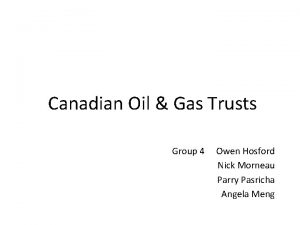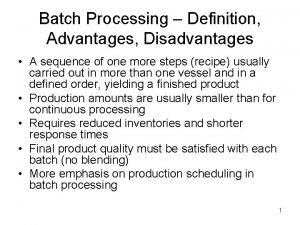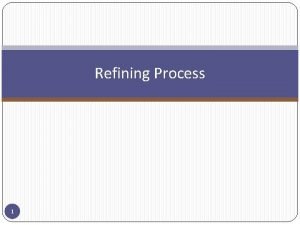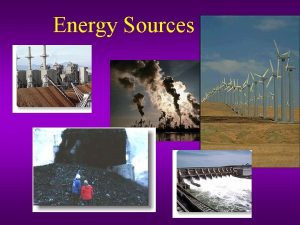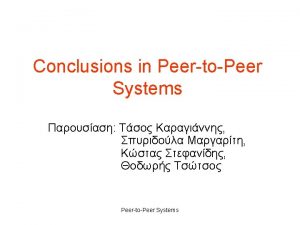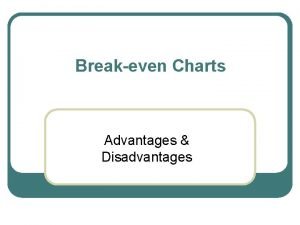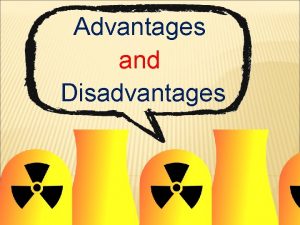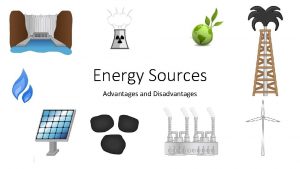Conventional Oil Has Advantages and Disadvantages Extraction processing


















- Slides: 18

Conventional Oil Has Advantages and Disadvantages § Extraction, processing, and burning of nonrenewable oil and other fossil fuels • Advantages • Disadvantages

Trade-Offs: Conventional Oil, Advantages and Disadvantages

15 -3 Will Heavy Oil Spills from Oil Sand Be a Viable Option? § Oil sand, tar sand contains bitumen § Canada and Venezuela: oil sand have more oil than in Saudi Arabia § Extraction • Serious environmental impact before stripmining • Low net energy yield: Is it cost effective?

Oil Sand Refinery

Will Oil Shales Be a Useable Resource? § Oil shales contain kerogen • After distillation: shale oil § 72% of the world’s reserve is in arid areas of western United States; there is a catch! • Locked up in rock • Lack of water needed for extraction and processing • Low net energy yield

Oil Shale Rock and the Shale Oil Extracted from It

Trade-Offs: Heavy Oils from Oil Shale and Oil Sand

15 -3 What Are the Advantages and Disadvantages of Natural Gas? § Concept 15 -3 Conventional natural gas is more plentiful than oil, has a high net energy yield and a fairly low cost, and has the lowest environmental impact of all fossil fuels.

Natural Gas Is a Useful and Clean. Burning Fossil Fuel (1) § Natural gas: mixture of gases • More than half is CH 4 (methane) § Conventional natural gas • Pipelines • Liquefied petroleum gas (LPG) • Liquefied natural gas (LNG) – low net energy yield § Unconventional natural gas • Coal bed methane gas • Methane hydrate

Trade-Offs: Conventional Natural Gas

15 -4 What Are the Advantages and Disadvantages of Coal? § Concept 15 -4 A Conventional coal is very plentiful and has a high net energy yield and low cost, but it has a very high environmental impact.

Coal Comes in Several Forms and Is Burned Mostly to Produce Electricity § Coal: solid fossil fuel § Burned in 2100 power plants, generates 40% of the world’s electricity • Inefficient § Three largest coal-burning countries • China • United States • Canada

Stages in Coal Formation over Millions of Years

Science: Coal-Burning Power Plant

Coal Is a Plentiful but Dirty Fuel (1) § World’s most abundant fossil fuel • U. S. has 25% § Environmental costs of burning coal • Severe air pollution • • Sulfur released as SO 2 Large amount of soot CO 2 Trace amounts of Hg and radioactive materials § Environmentalists call for • Taxation on CO 2 production by power plants • Cleaner coal-burning plants

CO 2 Emissions Per Unit of Electrical Energy Produced for Energy Sources

Coal Has Advantages and Disadvantages § § § Single biggest air polluter in coal-burning countries One-fourth of the annul CO 2 emissions Many opposed to new coal-burning power plants Advantages Disadvantages

Trade-Offs: Coal, Advantages and Disadvantages as an Energy Resource
 Chelex dna extraction advantages and disadvantages
Chelex dna extraction advantages and disadvantages Advantages and disadvantages of palm oil
Advantages and disadvantages of palm oil Synthetic crude oil
Synthetic crude oil Identification test for emulsion
Identification test for emulsion Batch production disadvantages
Batch production disadvantages Disadvantages of conventional energy
Disadvantages of conventional energy Serial extraction sequence
Serial extraction sequence Naphthenes in crude oil
Naphthenes in crude oil High boost filtering matlab
High boost filtering matlab Example of secondary processing
Example of secondary processing Batch processing and interactive processing
Batch processing and interactive processing Disadvantages of theobroma oil
Disadvantages of theobroma oil Displacement value
Displacement value Advantages of using oil
Advantages of using oil Arc phenomenon in circuit breaker
Arc phenomenon in circuit breaker Hub and-spoke vs point-to-point pros and cons
Hub and-spoke vs point-to-point pros and cons Define brazing
Define brazing Advantages and disadvantages of the north and south
Advantages and disadvantages of the north and south What is manual input devices
What is manual input devices


